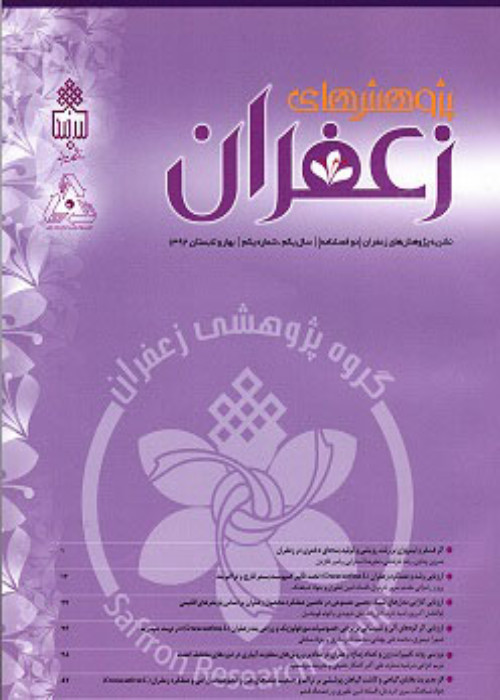The Effect Potassium Sulfate and Seaweed Extract on the Photosynthetic Pigments of Leaves and Some Stigma Active Substances of Saffron (Crocus sativus L.)
Saffron (Crocus sativus L.) is the most expensive agricultural product and one of the most valuable medicinal and spice plants that have many uses in the food and medicine industries. Iran is the largest producer and exporter of saffron in the world, and about 90% of the world's annual saffron production is produced in Iran, mainly in Razavi Khorasan and South Khorasan provinces. A balanced supply of nutrients is one of the main important factors in the sustainable saffron production, especially in arid and semi-arid areas. Potassium and sulfur, as two essential and widely used elements, play a significant role in the synthesis of proteins, activating enzymes, transferring sugar, increasing carbon dioxide absorption and photosynthesis. Seaweed extract is also one of the compounds that stimulate plant growth and the quality of products. The aim of this study was to investigate the effect of potassium sulfate and seaweed extract on the stigma quality and the content of leaf photosynthetic pigments.
This experiment was carried out in the growing seasons of 2018 and 2019, as factorial based on a randomized complete block design with three replications, in Sarayan, Iran. Experimental factors were four levels of potassium sulfate (0, 100, 200, and 300 kg ha-1) and three levels of Acadian seaweed (0, 1, and 2 per thousand). Before conducting the experiment, soil sampling was done from a depth of 0-30 cm (Table 1). Plots dimension was 2×1 m, with for planting rows in each. The distance between the plots was 0.5 m and between the blocks was 1.5 m. Before planting, the corms (8-10 g) were disinfection with benomyl fungicide. Potassium sulfate applied simultaneously with corms planting. For application of seaweed extract, after preparing the solutions with desired concentrations, foliar spraying was done using a sprayer three times in 20th February and 5th and 20th March, 2018. The flowers in the first growing season (autumn of 2017), were not harvested, because the treatments were not yet fully applied. Simultaneously with the beginning of flowering, in the second flowering season (in late November 2018), the flowers of each plot were collected daily. The stigmas were dried under laboratory condition at the shade for a week. Then, the qualitative parameters of stigma (anthocyanin, antioxidant, phenol, crocin, picrocrocin and safranal) were measured. In addition, during vegetative growth, the content of photosynthetic pigments (carotenoids, chlorophylls a, b and total) of leaves were determined. Statistical analysis of data was done using SAS 9.4 software. Means were compared using a protected LSD test at the 5% level of probability.
The interaction effect of experimental factors was significant on the content of picrocrocin, safranal and antioxidant of stigma as well as the amount of chlorophyll and carotenoid in the leaves. The highest amounts of picrocrocin, safranal and antioxidant activity were obtained in the combined application of 300 kg ha-1 potassium sulfate + foliar spraying of seaweed extract with a concentration of 2 per thousand, which were respectively, 32.8, 23.9 and 21.1% more than the control treatment (no use of potassium sulfate and seaweed extract). The highest values of chlorophyll a, chlorophyll b, total chlorophyll and carotenoids (0.17, 0.037, 1.99 and 1.01 mg g-1 FW, respectively) were gained with the combined application potassium sulfate (100 to 300 kg ha-1) plus seaweed extract (1-2 per thousand), which were 54.4, 60.8, 131.3 and 68.3% higher than the control, respectively. The simple effect of experimental factors was significant on crocin and anthocyanin content of stigma. Increasing the application rate of potassium sulfate from 0 to 300 kg ha-1, improved the amount of crocin by three times and the amount of anthocyanin by 8.9%. In addition, the amount of crocin and anthocyanin in the condition of seaweed extract application (concentration of 2 parts per thousand) was 166.7 and 12.7% higher than the control (no-seaweed application).
Based on the results of this research, the combined application of potassium sulfate and seaweed extract is recommended to improve the biochemical properties and bioactive compounds of saffron.
- حق عضویت دریافتی صرف حمایت از نشریات عضو و نگهداری، تکمیل و توسعه مگیران میشود.
- پرداخت حق اشتراک و دانلود مقالات اجازه بازنشر آن در سایر رسانههای چاپی و دیجیتال را به کاربر نمیدهد.




